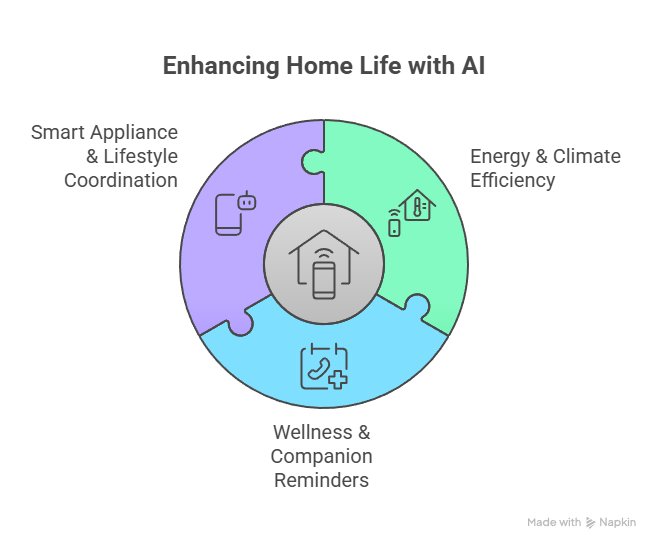Meta Description
AI home companions use autonomous intelligence to learn routines, save energy, and support health—transforming daily living with smart, seamless help.
1. Smart Climate Control: Saving Energy with Nest
Story: Nest Learning Thermostat in Real Homes
The Nest Learning Thermostat adjusts home temperature using AI. It learns your schedule, detects occupancy, and changes settings—even integrating weather forecasts for seasonal adjustments.
A study involving 735 homes for gas and 624 homes for electricity found:
- 10% reduction in gas usage
- 17.5% reduction in electricity use
(compared to pre-installation baselines after one year) wired.com+2aicompetence.org+2fpciw.org+2bhg.com+12en.wikipedia.org+12en.wikipedia.org+12
How It Works
- Data analysis: learns heating/cooling patterns
- Autonomic decisions: shifts temperature when you leave or return
- Decision-making integration: adjusts for weather and season
Practical Setup
- Install learning thermostat and link Wi‑Fi
- Let it learn your routines for 1–2 weeks
- Enable weather syncing and use home/away modes
- Review monthly energy reports
2. Whole-Home Coordination: Samsung Ballie as Personal Assistant
Story: Samsung’s Ballie Robot
Samsung is introducing Ballie, a mobile AI companion that integrates with SmartThings ecosystem. A recent pilot showcased capabilities to:
- Monitor pets via camera
- Project workout prompts after gym detection
- Manage appliances like managing laundry energy and schedules link.springer.com+15en.wikipedia.org+15thesun.ie+15researchgate.net+3aicompetence.org+3mhealth.jmir.org+3thesun.iearxiv.org+6theaustralian.com.au+6en.wikipedia.org+6
It also adjusts laundry cycles—using up to 60% less energy by choosing cold cycles intelligently en.wikipedia.org+8theaustralian.com.au+8aicompetence.org+8.
How It Functions
- Data analysis: detects pets, activities, and appliance usage
- Autonomy: moves and interacts without manual commands
- Decision-making: starts tasks (like laundry), monitors environment
Practical Setup
- Use SmartThings hub with AI-enabled devices
- Pair appliances with Ballie for energy-aware automation
- Configure pet monitoring and home routines
- Ensure local voice security via Knox integration
3. Wellness & Companionship: Alexa Reducing Loneliness
Study: Alexa’s Role in Reducing Isolation
A clinical trial with 50 older adults living alone showed:
- Daily use of Alexa routines
- UCLA Loneliness Scale dropped by ~10.9 points after intervention aicompetence.org+10agmr.hapres.com+10pmc.ncbi.nlm.nih.gov+10aicompetence.orgtheaustralian.com.aurobinbrewer.com
Participants received reminders, social interaction via voice, and daily engagement prompts—leading to improved wellbeing and connection.
How It Operates
- Data analysis: learns usage patterns over time
- Autonomy: proactively offers companionship and check-ins
- Decision-making: provides reminders for meds, appointments, or social chat
Practical Setup
- Place voice assistant in common area
- Enable daily wellness routines (e.g., “morning check-in”)
- Use voice cues to simulate interaction (“How’s your day?”)
- Integrate with calendar, medication, and emergency functions
Why AI Agents at Home Make a Difference
These real-world implementations demonstrate:
- Proactive automation: AI adjusts behaviors seamlessly
- Data-driven insights: learns from patterns for optimized performance
- Decision-making autonomy: acts without constant user input
They enhance comfort, safety, health, and energy savings without being intrusive.
Getting Started: 3 Core Ways to Leverage AI at Home
- Energy & Climate Efficiency
- Install a learning thermostat (e.g., Nest)
- Review energy savings via utility reports
- Expand to include water heating and lighting automation
- Wellness & Companion Reminders
- Use voice assistant for social prompts and reminders
- Set wellness routines that adapt to your schedule
- Smart Appliance & Lifestyle Coordination
- Integrate devices using platforms like SmartThings
- Leverage mobile agents (e.g., Ballie) for activity-aware assistance
- Automate daily tasks with appliance energy mode

Conclusion
AI home companions—from thermostats to robots and voice assistants—are no longer futuristic toys. These intelligent agents learn, adapt, and streamline home life across energy, wellness, and convenience. By starting with a single use case, anyone can begin enjoying a smarter, more responsive living space.
References
- “Energy Savings from the Nest Learning Thermostat,” Nest Labs study, 2015 (updated May 2024) pmc.ncbi.nlm.nih.govagmr.hapres.comcustomerthink.com+10aicompetence.org+10researchgate.net+10thesun.ie+2arxiv.org+2aicompetence.org+2researchgate.net+11en.wikipedia.org+11aicompetence.org+11aicompetence.org+3news.com.au+3thesun.ie+3theaustralian.com.au
- “Samsung Ballie AI Home Robot,” The Australian, Jan 2025; smart appliance integration and energy savings theaustralian.com.au
- “AI-powered Voice Assistants Reduce Loneliness,” AGMR Pilot Study, 2024 agmr.hapres.com
Tags: AI agents, smart home, energy efficiency, wellness AI, home automation, intelligent assistant
